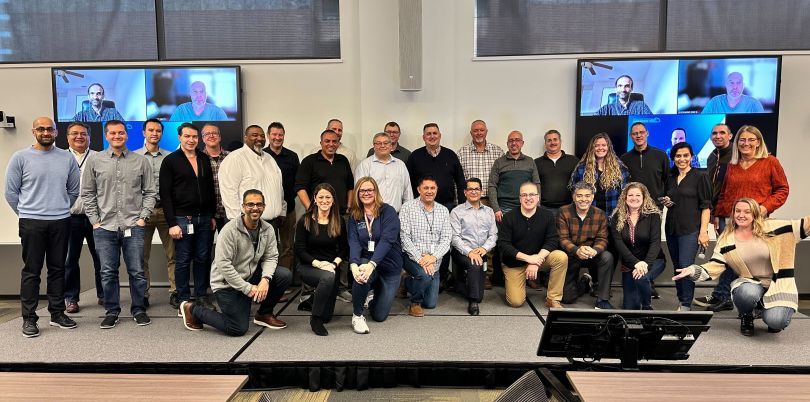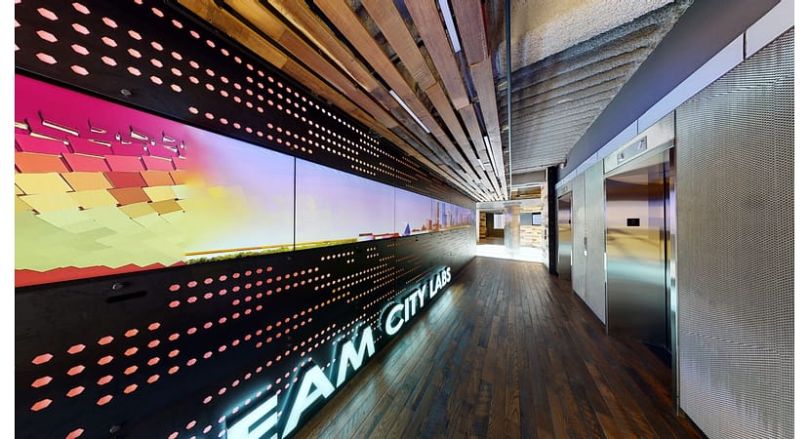Great talent doesn’t have to fit within a box — it can push and bend the job-requirement parameters to meet individuals’ unique background and skill sets.
For Ahmed Azam, vice president of infrastructure and cloud services at Northwestern Mutual, a team comprised of diverse backgrounds — paired with an open mind and a thirst for learning — has been an asset for technology teams in his experience.
“We’ve found success with people who have all kinds of interesting backgrounds: math majors, art majors, computer science majors,” Azam said. “But the key that they all had was they all learned.”
Azam is well-versed in the professional dividends that an open mind and a desire to learn can yield at the Milwaukee-headquartered financial services company. His roots at Northwestern Mutual trace back more than 20 years; he first started as an intern within the company’s technology department in 2001.
“It was one of those dream companies that everybody aspires to get into,” the University of Wisconsin-Milwaukee graduate recalled. “My background was really in finance and technology. Working at Northwestern Mutual was the perfect combination of the two.”
Azam is well-versed in the professional dividends that an open mind and a desire to learn can yield at Northwestern Mutual.
That initial internship set into motion a decades-long career that has seen Azam ascend the engineering ranks and take on and lead projects of grander scope and complexity. For example, Azam highlights a reimplementation of the company’s expense management system as a particularly pivotal project for his career arc.
In 2021, he moved into what he described as a “really fascinating opportunity” within incident management on the infrastructure team. Although it was a direction he hadn’t planned on going, it was a pivotal transition.
Now, in addition to running infrastructure and cloud services, Azam also oversees Northwestern Mutual’s digital workplace and, along with other key tech leaders, helps steer what he calls the “simplified accelerated technology strategy.” In sum, he leads an operation of what he estimates to be approximately 1,000 colleagues.
An exciting role for someone who, as he said, “stumbled upon infrastructure.”
“There have been many, many times throughout my career that I was given accountability for something I had no idea about,” Azam said. “I didn’t go to school for networking to understand all the bits and bytes of how servers are configured. These were all things that I learned as part of the job.”
Those years of experience have culminated into steering how he and his fellow technologists build the internal ecosystem that nurtures their big-picture, shared goal.
“We’ve got an incredible mission: To relieve Americans of financial anxiety. We’ve got all the resources at our disposal and we’ve got this incredible spectrum of technology,” Azam said. “How can we use that technology to solve real problems for our business in a meaningful, thoughtful way?”

Building On Heritage
Northwestern Mutual’s roots run deep — as Azam points out, it’s “a company that’s got more than 165 years of legacy.”
“What’s fascinating about Northwestern Mutual is we’ve got the latest technology. We’ve got Kubernetes. We’ve got cloud computing. We’re focused on things like artificial intelligence. We’ve got all that. We’ve also got the mainframe, and 50-year-old code,” Azam said. “The interesting challenge is: ‘How can we live in both of these worlds and, from a business lens, thoughtfully solve the challenges this company has?’”
For Azam, it’s all about being thoughtful about the ways in which he and his team go about leaning into their domain, moving deliberately with an eye to the future while knowing the full scope and implications of their tech choices. In other words, it’s about respecting what’s come before them while eyeing what’s around the corner.
One area that Azam feels the business has been prescient is with the cloud, calling the company “very early adopters” of the technology, which kicked off with engaging the Beta release of Kubernetes.
Now, many of the company’s flagship applications and systems are on the cloud, Azam said, with a focus on security, stability, reliability and compliance, as well as an eye on automation to make engineers’ jobs easier.
“Where I think it’s going to progress into the future is: How do we limit choice to the things that make a lot of business sense, while still allowing for a lot of creativity of our developers at the right levels?” Azam said. “We shouldn’t have developers be creative on the infrastructure side. They should be really creative in solving those business problems that are core to our mission.”
“We shouldn’t have developers be creative on the infrastructure side. They should be creative in solving business problems that are core to our mission.”
While Azam is excited about plenty of future-forward work — machine learning-powered accelerated underwriting is one area he spoke enthusiastically about — he sees the cloud as being particularly important to the company’s flagship product, its Planning Experience platform.
PX is a cloud-built tool used by Northwestern Mutual’s financial advisors to map out the best comprehensive financial plans for their clients. Given the number of considerations and variables involved, this work demands a dexterous, reliable tool.
“PX uses an incredible amount of computing resources on the back end. It’s able to take all kinds of different scenarios that you may have in your life, run those, and say: ‘Here’s how this gets modeled out for the next 50 years. Here are products that meet those financial needs,’” Azam said. “And, then, if things should change, we should be able to run another algorithm and provide you a totally different perspective.”
For example, AI and machine learning are speeding up the processes in the company’s underwriting efforts, in some cases taking weeks of work and reducing it to a manner of days via technology. “This speeds up the time to deliver new insurance policies to our clients,” Azam said.
When it comes to leaning more and more into the cloud, there’s a ripple effect to the scope of Azam’s team’s work, too, that extends beyond internal considerations and implications.
“Ultimately, it comes down to being able to see their requirements manifested faster than they would have been previously,” Azam said. “We’ve got to deliver business value for them faster and pivot to align with the market conditions sooner.”

Impact All Around
Azam has a refrain that he said he frequently emphasizes to company leadership.
“Infrastructure doesn’t actually serve any purpose in isolation. It is only useful when it solves business problems,” he said.
The ability to solve business problems means developing, delivering and maintaining technology that empowers — not stymies — colleagues in their roles.
“The platforms and infrastructure that we build have to get used by our application engineering community,” Azam said.
That means being able to speed up their ability to address the needs of the business.
“In the past, if I needed a server or database — some middleware component — it was a ticket to a person that, a week later, would spin something up in a non-production environment and, two weeks later, would get into production,” Azam said. “That’s way too slow. We can’t take six weeks to get just the infrastructure up and running. We’ve got to be able to do that in minutes through automation so that the business can ultimately see their requirements fulfilled much faster.”
Azam said that this use of automation and the cloud also affords space to experiment — and, if needed, pivot accordingly.
“The team should be able to innovate and play with different kinds of capabilities. Machine learning is a great example,” he said. “Where does that exactly fit into our business? Some of that we know and some of that we have yet to discover. We’ve got to be able to do that quickly, and then be able to scrap it and try something else again, quickly. I think it can only happen with the cloud.”
AZAM’S CLOUD COMPUTING TRENDS FOR 2023
- “Cloud can be really expensive if not done right. Now, with all of the macroeconomic pressures, everybody’s looking at how to rein in costs. And when I say costs, I actually mean value. Are we getting the value we wanted? Just because it’s in the cloud doesn't actually make it more valuable. Is it actually able to meet the business needs of flexibility, change and agility?”
- “Cloud has become very complex. I think we’re going to start seeing much more opinionation for business needs, with choices that make sense for us: types of databases, types of middleware, types of storage. We're going to say: ‘This is the way that this computing works. We’re going to provide the opinion and the pathway. Your opinions should be on the business logic.’ We’re going to provide that in a very automated way that’s much more maintainable, as well.”
Learners Wanted
While there’s plenty of chatter about what’s abuzz in the cloud, there’s ample developments on the ground, too.
In February, Northwestern Mutual announced that it would invest more than $500 million into one of its downtown office buildings, which sits on the company’s Milwaukee HQ campus.
Azam is personally excited, too, over recent news that the company would be bidding adieu to its current primary data center. “This will give us an opportunity to see how we can actually accelerate many of the strategic components of our cloud journey, our cloud migration and our simplification efforts,” Azam said.
For those who want to come along for the ride, Azam has words of wisdom to professionals who want to make a career in enterprise technology.
First, don’t forget the core tenets: “The fundamentals of technology are always going to be important: security, reliability, scale,” he said.
“The fundamentals of technology are always going to be important: security, reliability, scale.”
What’s more, he recommends learning “ubiquitous technologies” like Python and JavaScript, whose diverse range of applications Azam believes create a firm foundation from which technologists can go down all sorts of paths.
Above all, though, Azam is clear about the qualities that he seeks for members of his team.
“For me, the number one thing is: I want learners,” he said. “I want people that are very, very open to learning.”






